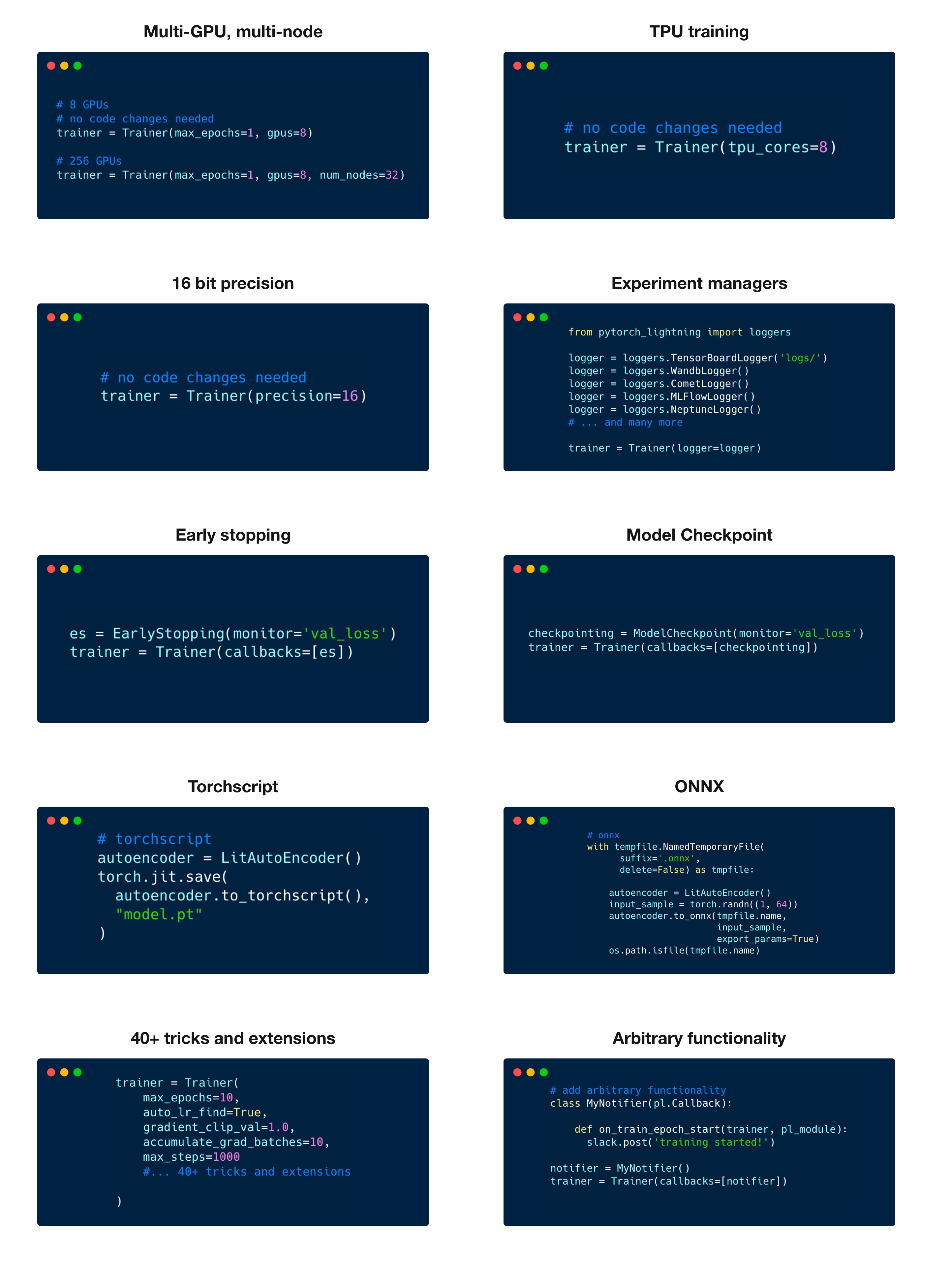This is learning Pytorch LightingAI Tutorials Repository Contains variety of Example of official Repository.
Few lines describing your project.
PyTorch Lightning is an open-source Python library that provides a high-level interface for PyTorch, a popular deep learning framework.[1] It is a lightweight and high-performance framework that organizes PyTorch code to decouple the research from the engineering, making deep learning experiments easier to read and reproduce. It is designed to create scalable deep learning models that can easily run on distributed hardware while keeping the models hardware agnostic.
In 2019, Lightning was adopted by the NeurIPS Reproducibility Challenge as a standard for submitting PyTorch code to the conference.[2]
In 2022, the PyTorch Lightning library officially became a part of the Lightning framework, an open-source framework managed by the original creators of PyTorch Lightning.
Simple installation from PyPI
pip install pytorch-lightningOther installation options
pip install pytorch-lightning['extra']conda install pytorch-lightning -c conda-forgeThe actual status of 1.7 [stable] is the following:
Install future release from the source
pip install https://github.com/Lightning-AI/lightning/archive/refs/heads/release/pytorch.zip -UInstall nightly from the source (no guarantees)
pip install https://github.com/Lightning-AI/lightning/archive/refs/heads/master.zip -Uor from testing PyPI
pip install -iU https://test.pypi.org/simple/ pytorch-lightningimport os
import torch
from torch import nn
import torch.nn.functional as F
from torchvision.datasets import MNIST
from torch.utils.data import DataLoader, random_split
from torchvision import transforms
import pytorch_lightning as plA LightningModule defines a full system (ie: a GAN, autoencoder, BERT or a simple Image Classifier).
class LitAutoEncoder(pl.LightningModule):
def __init__(self):
super().__init__()
self.encoder = nn.Sequential(nn.Linear(28 * 28, 128), nn.ReLU(), nn.Linear(128, 3))
self.decoder = nn.Sequential(nn.Linear(3, 128), nn.ReLU(), nn.Linear(128, 28 * 28))
def forward(self, x):
# in lightning, forward defines the prediction/inference actions
embedding = self.encoder(x)
return embedding
def training_step(self, batch, batch_idx):
# training_step defines the train loop. It is independent of forward
x, y = batch
x = x.view(x.size(0), -1)
z = self.encoder(x)
x_hat = self.decoder(z)
loss = F.mse_loss(x_hat, x)
self.log("train_loss", loss)
return loss
def configure_optimizers(self):
optimizer = torch.optim.Adam(self.parameters(), lr=1e-3)
return optimizerNote: Training_step defines the training loop. Forward defines how the LightningModule behaves during inference/prediction.
dataset = MNIST(os.getcwd(), download=True, transform=transforms.ToTensor())
train, val = random_split(dataset, [55000, 5000])
autoencoder = LitAutoEncoder()
trainer = pl.Trainer()
trainer.fit(autoencoder, DataLoader(train), DataLoader(val))Lightning has over 40+ advanced features designed for professional AI research at scale.
Here are some examples:
Highlighted feature code snippets
# 8 GPUs
# no code changes needed
trainer = Trainer(max_epochs=1, accelerator="gpu", devices=8)
# 256 GPUs
trainer = Trainer(max_epochs=1, accelerator="gpu", devices=8, num_nodes=32)Train on TPUs without code changes
# no code changes needed
trainer = Trainer(accelerator="tpu", devices=8)16-bit precision
# no code changes needed
trainer = Trainer(precision=16)Experiment managers
from pytorch_lightning import loggers
# tensorboard
trainer = Trainer(logger=TensorBoardLogger("logs/"))
# weights and biases
trainer = Trainer(logger=loggers.WandbLogger())
# comet
trainer = Trainer(logger=loggers.CometLogger())
# mlflow
trainer = Trainer(logger=loggers.MLFlowLogger())
# neptune
trainer = Trainer(logger=loggers.NeptuneLogger())
# ... and dozens moreEarlyStopping
es = EarlyStopping(monitor="val_loss")
trainer = Trainer(callbacks=[es])Checkpointing
checkpointing = ModelCheckpoint(monitor="val_loss")
trainer = Trainer(callbacks=[checkpointing])Export to torchscript (JIT) (production use)
# torchscript
autoencoder = LitAutoEncoder()
torch.jit.save(autoencoder.to_torchscript(), "model.pt")Export to ONNX (production use)
# onnx
with tempfile.NamedTemporaryFile(suffix=".onnx", delete=False) as tmpfile:
autoencoder = LitAutoEncoder()
input_sample = torch.randn((1, 64))
autoencoder.to_onnx(tmpfile.name, input_sample, export_params=True)
os.path.isfile(tmpfile.name)For complex/professional level work, you have optional full control of the training loop and optimizers.
class LitAutoEncoder(pl.LightningModule):
def __init__(self):
super().__init__()
self.automatic_optimization = False
def training_step(self, batch, batch_idx):
# access your optimizers with use_pl_optimizer=False. Default is True
opt_a, opt_b = self.optimizers(use_pl_optimizer=True)
loss_a = ...
self.manual_backward(loss_a, opt_a)
opt_a.step()
opt_a.zero_grad()
loss_b = ...
self.manual_backward(loss_b, opt_b, retain_graph=True)
self.manual_backward(loss_b, opt_b)
opt_b.step()
opt_b.zero_grad()- Models become hardware agnostic
- Code is clear to read because engineering code is abstracted away
- Easier to reproduce
- Make fewer mistakes because lightning handles the tricky engineering
- Keeps all the flexibility (LightningModules are still PyTorch modules), but removes a ton of boilerplate
- Lightning has dozens of integrations with popular machine learning tools.
- Tested rigorously with every new PR. We test every combination of PyTorch and Python supported versions, every OS, multi GPUs and even TPUs.
- Minimal running speed overhead (about 300 ms per epoch compared with pure PyTorch).
- @Ashish Patel - Idea & Initial work
See also the list of contributors who participated in this project.
- "GitHub - PyTorch Lightning". 2019-12-01.
- "Reproducibility Challenge @NeurIPS 2019". NeurIPS. 2019-12-01. Retrieved 2019-12-01.
- https://github.com/Lightning-AI/lightning
- https://uvadlc-notebooks.readthedocs.io/en/latest/tutorial_notebooks/





